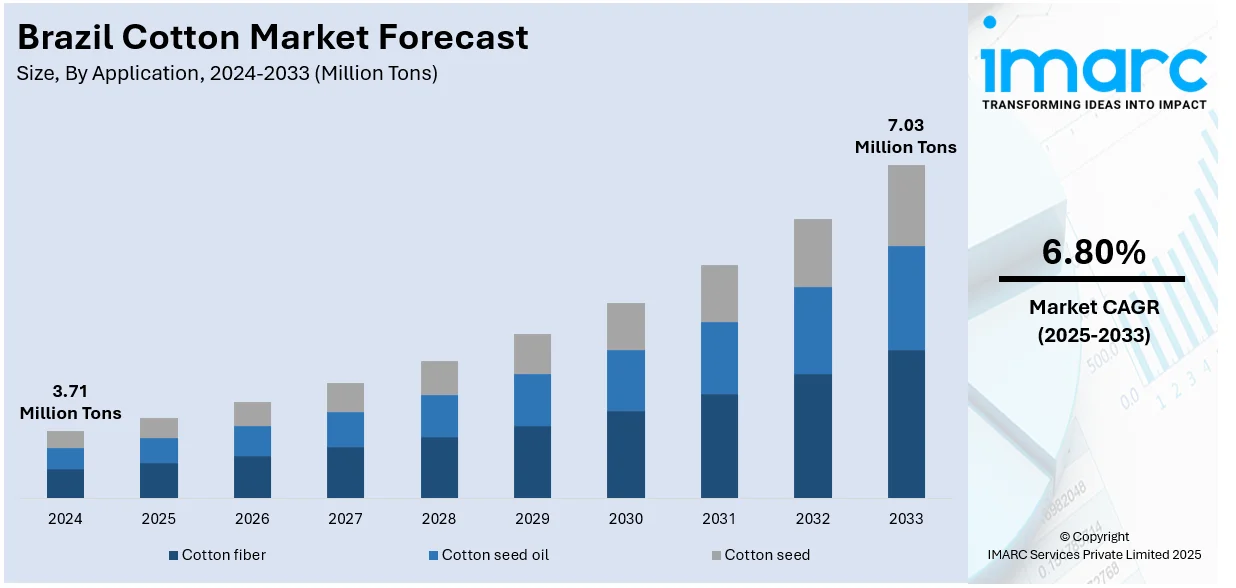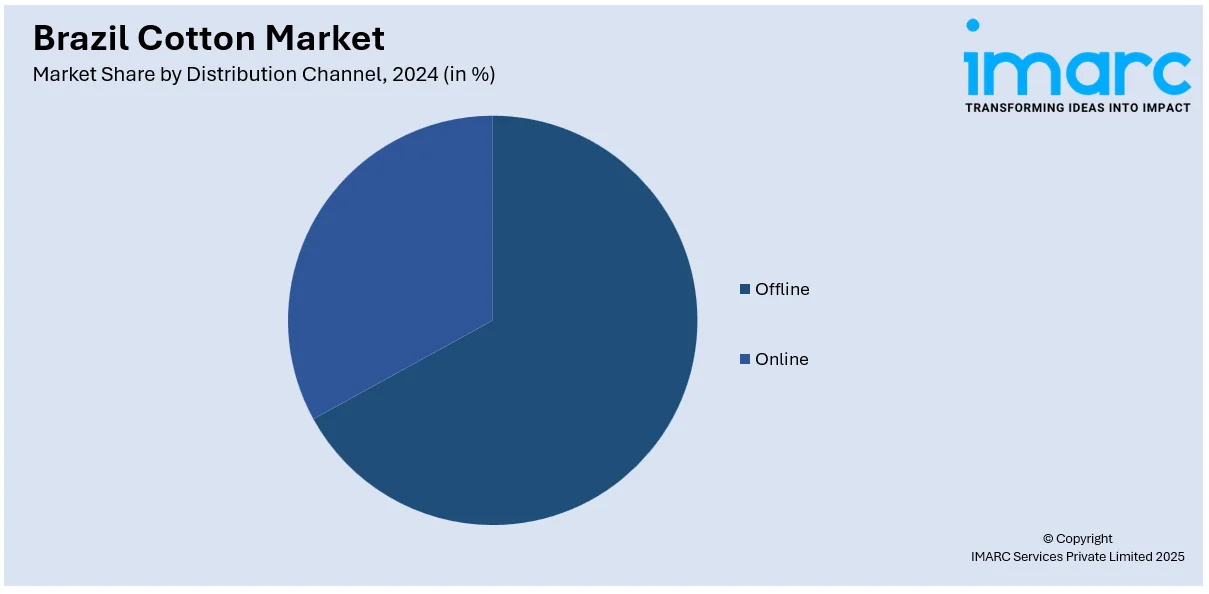
Brazil Cotton Market Size, Share, Trends and Forecast by Application, Distribution Channel, and Region, 2025-2033
Brazil Cotton Market Size and Share:
The Brazil cotton market size reached 3.71 Million Tons in 2024. Looking forward, IMARC Group expects the market to reach 7.03 Million Tons by 2033, exhibiting a growth rate (CAGR) of 6.80% during 2025-2033. The market is experiencing rapid expansion due to favorable climatic conditions, the availability of abundant arable land, rapid technical improvements in agriculture, rising global demand, government support and legislation, and broad acceptance of sustainable methods.
|
Report Attribute
|
Key Statistics
|
|---|---|
|
Base Year
|
2024
|
|
Forecast Years
|
2025-2033
|
|
Historical Years
|
2019-2024
|
| Market Size in 2024 | 3.71 Million Tons |
| Market Forecast in 2033 | 7.03 Million Tons |
| Market Growth Rate (2025-2033) | 6.80% |
Brazil Cotton Market Trends:
Favorable Climate and Large Arable Land
Brazil is currently one of the world's leading producers of cotton due to its wide-ranging fertile land and ideal climate. Brazil's varied topography provides a wide variety of climates, with the central and western areas being especially suited for growing cotton. The ideal circumstances for high cotton yields are a long growing season, enough sunlight, and evenly distributed rainfall throughout the main cotton-producing regions. Farmers are able to utilize large-scale farming techniques, which improve economies of scale and reduce production costs, by maximizing the quantity of land. By virtue of these inherent advantages, the nation's cotton production is greater in effectiveness and requires less expensive irrigation infrastructure and artificial inputs.

Rising Global Demand
Upgraded demand for Brazilian cotton materializes through textile and apparel production over the recent period. The high quality of Brazilian cotton secures its strong market position worldwide. According to the reports, in January 2025, Brazil officially became the world's largest cotton exporter, surpassing the U.S., with over 3.7 million tons produced in the 2023-24 harvest, driven by innovation, sustainability, and market demand. Furthermore, Brazil keeps its position as a leading cotton exporter through extensive production capabilities that supply large quantities of cotton for export. Brazil has achieved the position of the world’s second-largest cotton exporting nation behind the United States. The market demand for natural fibers keeps increasing because consumers worldwide understand how synthetic alternatives endanger the environment. The favorable production expenses at Brazil's facilities allow textile industries to purchase cotton at competitive prices since they heavily depend on imports for their production needs.
Technological Advancements in Agriculture
Technological advancements have been the key to Brazil's cotton market expansion. Genetically modified (GM) varieties of cotton have increased resistance to pests and disease, lessening the use of chemical pesticides and increasing overall yields. For instance, in October 2024, Agro Amazônia launched its cotton seed brand, Dagma Algodão, targeting 7,000 bags in 2024/25. The genetically modified seeds promise higher fiber yield, enhancing Brazil’s cotton industry. Moreover, these technologies help farmers optimize planting density, irrigation, and fertilization, leading to more efficient use of resources and higher productivity. Brazil has also invested heavily in mechanized harvesting equipment, which reduces labor costs and increases the speed of harvests, allowing for better handling of large-scale cotton farming operations.
Brazil Cotton Market Segmentation:
IMARC Group provides an analysis of the key trends in each segment of the market, along with forecasts at the region level for 2025-2033. Our report has categorized the market based on application and distribution channel.
Application Insights:
- Cotton fiber
- Cotton seed oil
- Cotton seed
The report has provided a detailed breakup and analysis of the market based on the application. This includes cotton fiber, cotton seed oil, and cotton seed.
Distribution Channel Insights:

- Offline
- Online
A detailed breakup and analysis of the market based on the distribution channel have also been provided in the report. This includes offline, and online.
Regional Insights:
- Southeast
- South
- Northeast
- North
- Central-West
The report has also provided a comprehensive analysis of all the major regional markets, which include Southeast, South, Northeast, North, and Central-West.
Competitive Landscape:
The market research report has also provided a comprehensive analysis of the competitive landscape. Competitive analysis such as market structure, key player positioning, top winning strategies, competitive dashboard, and company evaluation quadrant has been covered in the report. Also, detailed profiles of all major companies have been provided.
Brazil Cotton Market News:
- In June 2024, FibreTrace established a partnership with Cargill and Target Corp. to advance real-time cotton verification in the US and Brazil throughout the global supply chain. Between the United States and Brazil, the partnership will result in 50,000 metric tons of raw cotton in its first year.
Brazil Cotton Market Report Coverage:
| Report Features | Details |
|---|---|
| Base Year of the Analysis | 2024 |
| Historical Period | 2019-2024 |
| Forecast Period | 2025-2033 |
| Units | Million Tons |
| Scope of the Report |
Exploration of Historical Trends and Market Outlook, Industry Catalysts and Challenges, Segment-Wise Historical and Future Market Assessment:
|
| Applications Covered | Cotton Fiber, Cotton Seed Oil, Cotton Seed |
| Distribution Channels Covered | Offline, Online |
| Regions Covered | Southeast, South, Northeast, North, Central-West |
| Customization Scope | 10% Free Customization |
| Post-Sale Analyst Support | 10-12 Weeks |
| Delivery Format | PDF and Excel through Email (We can also provide the editable version of the report in PPT/Word format on special request) |
Key Questions Answered in This Report:
- How has the Brazil cotton market performed so far and how will it perform in the coming years?
- What is the breakup of the Brazil cotton market on the basis of application?
- What is the breakup of the Brazil cotton market on the basis of distribution channel?
- What is the breakup of the Brazil cotton market on the basis of region?
- What are the various stages in the value chain of the Brazil cotton market?
- What are the key driving factors and challenges in the Brazil cotton?
- What is the structure of the Brazil cotton market and who are the key players?
- What is the degree of competition in the Brazil cotton market?
Key Benefits for Stakeholders:
- IMARC’s industry report offers a comprehensive quantitative analysis of various market segments, historical and current market trends, market forecasts, and dynamics of the Brazil cotton market from 2019-2033.
- The research report provides the latest information on the market drivers, challenges, and opportunities in the Brazil cotton market.
- Porter's five forces analysis assist stakeholders in assessing the impact of new entrants, competitive rivalry, supplier power, buyer power, and the threat of substitution. It helps stakeholders to analyze the level of competition within the Brazil cotton industry and its attractiveness.
- Competitive landscape allows stakeholders to understand their competitive environment and provides an insight into the current positions of key players in the market.
Need more help?
- Speak to our experienced analysts for insights on the current market scenarios.
- Include additional segments and countries to customize the report as per your requirement.
- Gain an unparalleled competitive advantage in your domain by understanding how to utilize the report and positively impacting your operations and revenue.
- For further assistance, please connect with our analysts.
 Inquire Before Buying
Inquire Before Buying
 Speak to an Analyst
Speak to an Analyst
 Request Brochure
Request Brochure
 Request Customization
Request Customization




.webp)




.webp)












